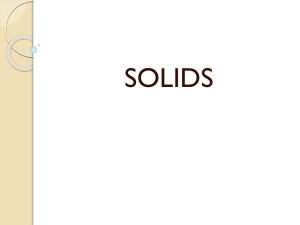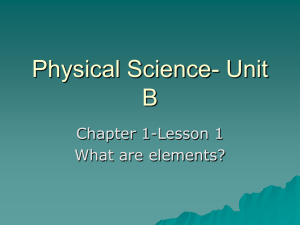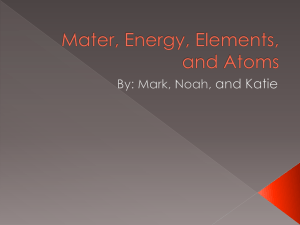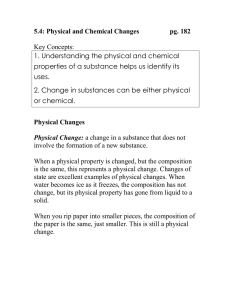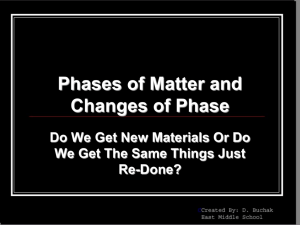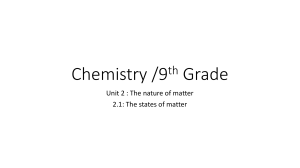Bell work Matter Objectives What is matter? Elements and Compounds
advertisement
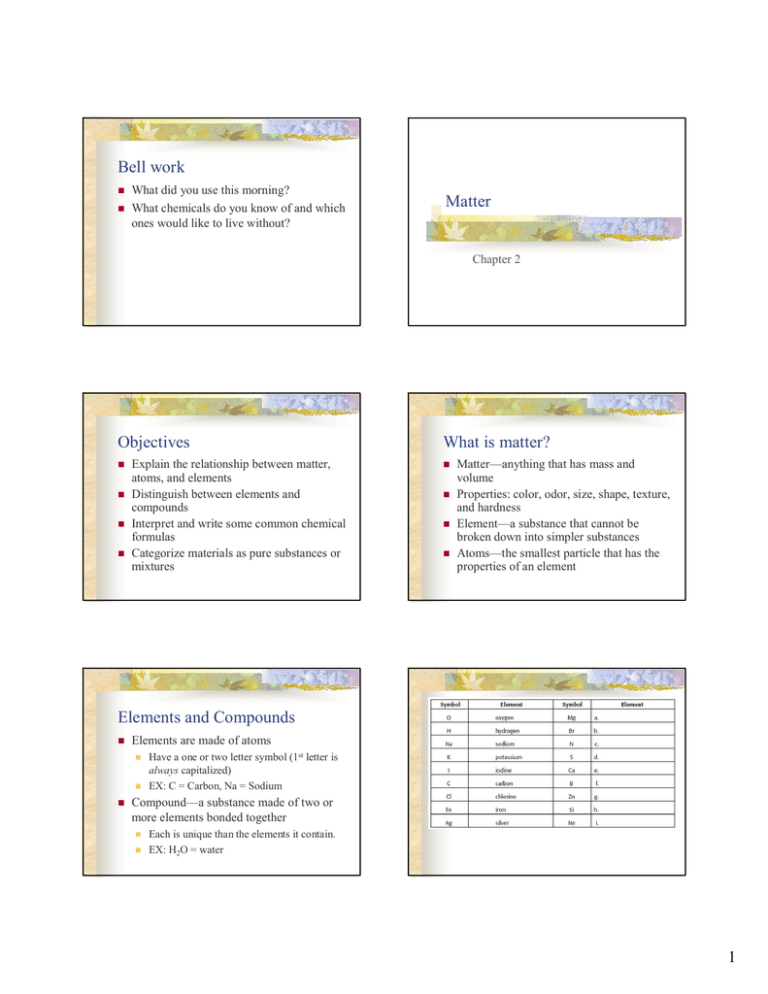
Bell work n n What did you use this morning? What chemicals do you know of and which ones would like to live without? Matter Chapter 2 Objectives n n n n Explain the relationship between matter, atoms, and elements Distinguish between elements and compounds Interpret and write some common chemical formulas Categorize materials as pure substances or mixtures What is matter? n n n n Matter—anything that has mass and volume Properties: color, odor, size, shape, texture, and hardness Element—a substance that cannot be broken down into simpler substances Atoms—the smallest particle that has the properties of an element Elements and Compounds n Elements are made of atoms n n n Have a one or two letter symbol (1 st letter is always capitalized) EX: C = Carbon, Na = Sodium Compound—a substance made of two or more elements bonded together n n Each is unique than the elements it contain. EX: H 2 O = water 1 Molecules n n n n Chemical Formulas n EX 1: KMT (Kinetic Molecular Theory) n n n n EX 2: 3C 16 H 10 N 2 O 2 n There are 48 C (carbon) 30 H (hydrogen) 6 N (nitrogen) 6 O (oxygen) and…..3 molecules States of Matter n n n n The chemical symbols and numbers indicating the atoms contained in the basic unit of a substance. Subscripts—the small number at the bottom right of the symbol—tells you how many atoms of that element are there. Coefficients—big number in front—tell you how many molecules you have. The smallest unit of a substance that exhibits all of the properties characteristic of that substance. EX: F 2 = fluorine, NO 2 = nitrogen dioxide Diatomic molecules: HNOF (8 elements)— a molecule of the same element that does not exist in nature by itself. Solid: definite shape and volume; particles vibrate Liquid: definite volume & takes the shape of its container; particles move past each other; a fluid Gas: change both shape and volume; particles move past each other; a fluid; low density Plasma: most common type; EX: sun and stars, lightning, fire, aurora borealis; conduct electric current n n n Matter is made of atoms and molecules They act like particles in constant motion The higher the temperature, the faster the particles move The more massive the particles are, the slower the move Phase Changes n n n n n Melting—change from solid to liquid (requires energy) Freezing—liquid to solid Evaporation—liquid to gas (requires energy) Condensation—gas to liquid Sublimation—solid to gas (no liquid state) 2 n n n n The law of conservation of…. n Mass—mass cannot be created nor destroyed n n Properties of Matter n EX: leaves changing color burning a match Energy—energy cannot be created nor destroyed Temperature—actual measurement of the average kinetic E of the random motion of particles in a substance. A measure of how hot or cold something is. As kinetic E increases, so does the temperature! Heat is the E that is being transferred and temperature is the measurement! n n Chemical properties—the way a substance reacts with others to form new substances Describes how a substance reacts EX: flammability Example of iron n n Physical properties—a characteristic of a substance EX: shape, odor, color, texture, melting point, boiling point, density, etc n n Chemical property: ability to rust (react with water) Physical property: magnetic, black 3 Bellwork n Why do we sweat? Density n n We sweat to cool off our body by means of evaporation. As the water (sweat) evaporates, it absorbs the heat from our body to turn into a gas leaving our body cooler! n n n Example If we know that 10.0 cm 3 of ice has a mass of 9.17 g, what is the density of the ice? V = 10.0 cm 3 m = 9.17 g Mass per unit volume D = m / V Float or sink? If an object is less dense than the liquid it is in……it floats If an object is more dense than the liquid it is in……it sinks Solution n D = m/V n D = 9.17g 10cm 3 n D = 0.917 g/cm 3 Chemical Changes n n The substance changes composition EX: charging a battery 4 Physical Changes n n Physical or Chemical…. The substance changes form EX: cutting, melting, dissolving n n n n n n Endothermic and Exothermic n Endothermic n n n Heat is ABSORBED the system EX: melting of ice & boiling of water & cold packs Makes objects feel cooler! n n n n Heat is RELEASED from the system EX: freezing of water & heat pack & glow sticks Makes objects feel hotter! Are the following elements or compounds? n n n S CH 4 How many of each atom do the following contain? n n n Graphs Exothermic Bellwork n A piece of wood burns to form ash Water evaporates into steam A bicycle chain rusts Milk sours A plant turns sunlight, CO 2 , and water into sugar and oxygen Water is absorbed by a paper towel Pure substances and Mixtures n n Pure substance—any matter that has a fixed composition and definite properties. Mixture—a combination of more than one pure substance H 2 O C 6 H 12 O 6 2CO 2 5 Types of Mixtures n Heterogeneous—substances are not uniformly mixed n n EX: salad, chocolate chip cookie, dirt Homogeneous—substances are the same throughout—also called a solution n EX: salt water, air, brass Heterogeneous Mixtures n n n Miscible—two liquids that are able to dissolve into each other Immiscible—two liquids that do not mix into each other Gases can dissolve in liquids n EX: soda n Suspensions—looks uniform but separates later n Colloid—mixture of tiny particles that do not settle out. n n n n n n Filtering Decanting—pouring off the liquid Centrifuge—separating by their densities EX: milk Emulsion—mixture of immiscible liquids spread throughout each other. Needs a protein n Separation Methods EX: orange juice EX: salad dressing, mayonnaise Solutions (Homogeneous) n n n EX: Salt water, air, brass (Cu & Zn) Solvation—the process of dissolving Solute—the substance that is being dissolved—the smallest amount. n n EX: Kool­Aid powder Solvent—the substance that does the dissolving—the larger amount n EX: water (most commonly used solvent) 6 Separation Methods n n n Solubility Curve Distillation—separating liquids based on their boiling points Chromatography—separating liquids based on how well they dissolve in a solvent Evaporation—boiling the liquid off to leave the solid behind. 7
